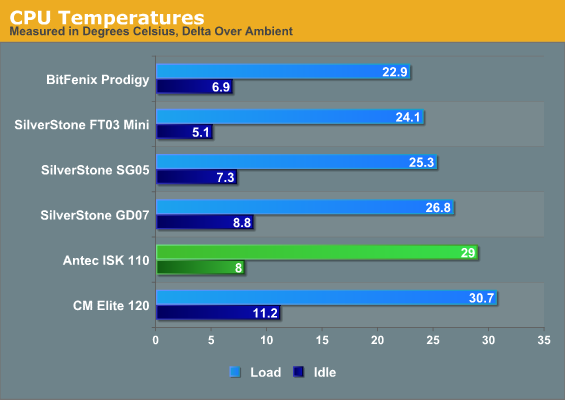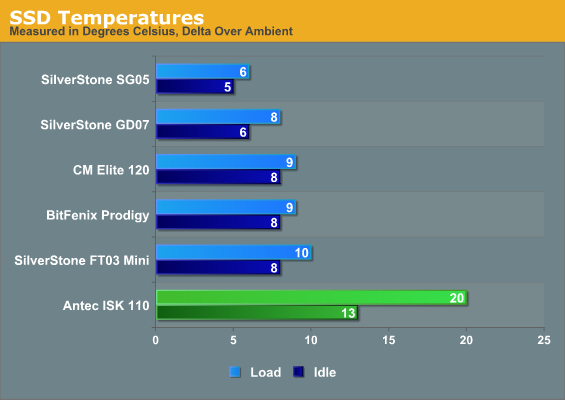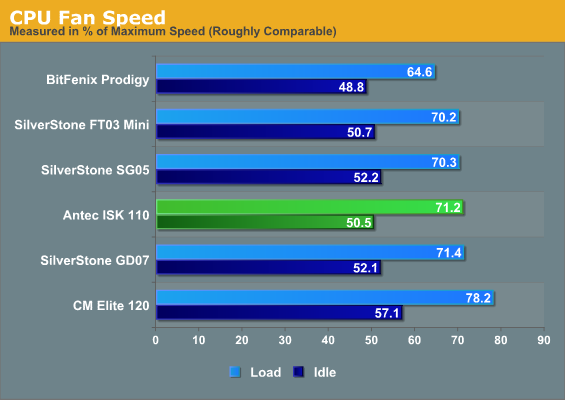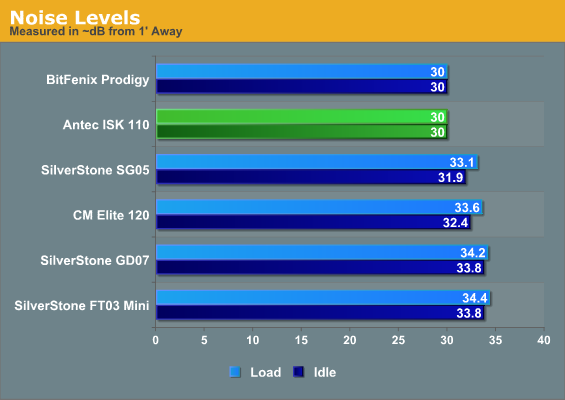Antec ISK 110 VESA Case Review: Just About As Small As It Gets
by Dustin Sklavos on August 31, 2012 12:01 AM EST- Posted in
- Cases/Cooling/PSUs
- Mini ITX
- Antec
Noise and Thermal Testing
Without anywhere to put a dedicated graphics card in the Antec ISK 110 VESA, testing winds up being a bit more truncated than we'd expect. In a way some of these results are going to seem academic, essentially reviewing SilverStone's NT07-1156 heatsink/fan unit about as much as the case itself.
Ambient temperature during testing hovered between 24C and 25C.


These test results are actually a little more interesting than I'd expected; despite the ventilation, the heatsink has to do all the work of keeping the CPU cool. With no directed airflow in the system outside of that, the processor actually runs notably warmer than in larger, more closed off cases with more directed airflow. Only the Cooler Master Elite 120, with its poor intake airflow, posts a worse temperature on the processor, but those thermals are still perfectly reasonable.
On the other hand, the SSD in the ISK 110 is running much hotter than I'd like. The bottom panel really needs more ventilation than it has; a peak temperature in the mid-40s is still within spec for most 2.5" drives, but that's with just a single SSD. A second drive, especially a mechanical hard drive, could bump thermals up a few degrees and start edging pretty close to 50C, which is spec for some drives.

Fan speed in the ISK 110 is middle of the road. As long as you're using a processor that runs fairly cool you shouldn't have too many issues with it; we still have some headroom on ours.

The flipside to the Antec ISK 110 VESA's design is that while it relies solely on the heatsink/fan combo to actively cool the system, it also relies solely on the heatsink/fan combo to actively cool the system. That means with a unit like the SilverStone one we use, the ISK 110 VESA can run comfortably quiet even under load.










53 Comments
View All Comments
DanNeely - Friday, August 31, 2012 - link
I'm a bit surprised they didn't go with something more like a pico-psu in general. Just using 12V in instead of 19V would allow for a significantly smaller board since you'd only need to make small amounts of 3.3/5V internally and not large amounts of 12V as well. Dropping the additional conversion should also boost total system efficiency and lower wall power as a result.Lonyo - Friday, August 31, 2012 - link
Yeah, the power circuitry based on the pics looks like a lot more than I would expect to be necessary given the size of a PicoPSU (I'm using on on an ITX system with G620T and HD6450, as well as 3x3.5" HDDs with no problems).If it's an ITX system with just 2.5" drives, there should be no issues with a low power PicoPSU instead of whatever they went with.
Alex_N - Friday, August 31, 2012 - link
I built three identical systems using this case, used i7 3770S (65W quad core) for the CPU and Intel's reference mini-ITX ivy bridge motherboard. I use them for a small CPU-heavy compute cluster.Pros:
-assembly was pretty easy. I was able to fit the motherboard in without removing the PSU.
-very low power (I can run them all off one power strip)
-very low noise... can't hear them running over the AC and my desktop, even with my head next to the case and at full load (obviously depends on your CPU fan, I'm using the stock cooler fan)
-very space efficient (the other mini-ITX cases are 3X as large)
-CPU runs cool at load
Cons:
-PSU runs very hot at load. Could be partially due to the tough cable management.
-one of the PSUs was dead out of the three. Replaced it with a PicoPSU, which was much smaller (and maybe runs cooler, too, but haven't checked closely)
It's been about 4-5 months and I'm very happy with them. Quiet compute cluster, low cost, low noise, low power consumption, fast boot times (SSD + new style BIOS - UEFI?). I'd consider building these for friends/relatives who need a non-gaming PC, as well.
fic2 - Friday, August 31, 2012 - link
I am curious as to what PicoPSU you replaced the PSU with.EnzoFX - Friday, August 31, 2012 - link
I love these things, but I don't understand why they can't do proper length cables, or include cables that would just fit well, as opposed to something at standard length. Furthermore, why cant' they make some custom connectors or adapters. It must be possible, for them to create maybe even a new standard to keep cables to a minimum size and length in these type of cases. The power is only going to so few devices that it should warrant custom cables perhaps? The ease of assembling and better airflow would be worth the marginal extra cost, surely?jhoff80 - Friday, August 31, 2012 - link
...but with most new mITX boards having a mSATA slot, I'd absolutely love to see a case with 0 drive bays but that still has two PCI expansion slots (preferably with a riser) to support a dedicated GPU.Wardrop - Friday, August 31, 2012 - link
Just a shame that Antec cases are always so ugly... or maybe out of date is a better description. Would have looked awesome back around the turn of the century, but otherwise, I think Lian Li are the only one's making attractive cases of this size (or a little larger).Scannall - Friday, August 31, 2012 - link
I agree, it really does look bad. I used a Wesna case for my HTPC.http://www.shop.perfecthometheater.com/HTPC-ITX2-B...
Looks far better.
Wardrop - Saturday, September 1, 2012 - link
That Wesna case is pretty nice. Thanks for the link.Anosh - Wednesday, November 7, 2012 - link
Expect it gets to warm